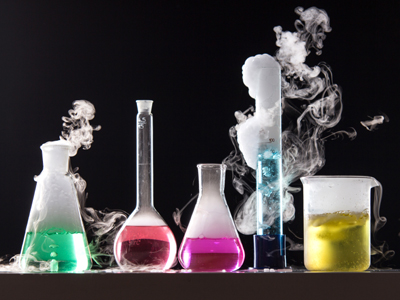Many factors affect rates of chemical reactions - pressure of gasses, temperature, surface area of solids, concentration and if there is a catalyst. Anything that will change the probability of particles colliding or change the energy of the collisions will affect the rate of a reaction. This is the first of three high school Chemistry quizzes looking at these factors.
The rate of a reaction is a measure of how quickly a chemical reaction progresses. Some reactions can be very slow, for example rusting can take weeks or even years, whilst others, such as neutralization or an explosion are over very rapidly. The rate of reaction is very important in industrial situations; take explosions for instance - these are incredibly fast reactions. An explosive is a solid that turns into a huge amount of very hot gas VERY quickly! This makes them useful for several purposes - most notably in warfare - though a more peaceful use is in the quarrying for resources.
At a quarry, they drill holes with a diameter of a few centimeters down into the rocks. They then drop sticks of explosives into the holes along with a detonator. The space above the explosives is then filled with something like sand or fine gravel. When the explosive is ignited (this is an increase in energy, one of the factors which affects the rate of a reaction), it vapourises in a fraction of a second, turning into a huge quantity of gas. The hole that was drilled is far too narrow for the gas to escape quickly. The trapped gas creates a huge pressure since it is confined in such a small volume and this pressure is enough to fracture the rocks, sending them flying into the air. You may have seen video footage of the effect of this fast reaction during your chemistry lessons. Before explosives, quarrying was a much slower and less spectacular process since the quarry workers used hammers and wedges to split the rocks apart. Where there were no natural cracks, they had to make their own holes by hand before they could drive the wedges into the rocks.
There are many different ways that you can follow the rate of reaction, you will have used some of them and seen others demonstrated during your high school studies. It all comes down to finding ways of measuring how fast the reactants are used up or how quickly the products are made. If one of the products is a gas that can safely be released into the air, life is easy! You can simply let it escape from the reaction vessel and measure how the mass decreases as the reaction proceeds. A better method is to collect the gas and measure how much is produced every few seconds. In a reaction between liquids, if an opaque precipitate or suspension is produced, less and less light will be transmitted through the liquids as the reaction progresses. You could stand the reaction vessel on a piece of paper with a cross on it and time how long it takes for the cross to be obscured. For a more technical solution, use data logging and a light sensor to measure how much light is transmitted through the mixture over the course of the reaction.
When measuring the rate of a reaction, what you can't do is just measure a factor at the start or at the end. This does not work, you need to measure something continuously during the reaction, in other words, your measurements must include time. It is best to start timing at the moment that the reactants are mixed and to continue measuring for as much of the reaction as possible. You will then be able to collect sufficient data for it to be both reliable and valid, from which you can plot one or more graphs to help you to draw your conclusions.
Have a go at this quiz and see how well you understand how to measure the rates of chemical reactions and the factors which will affect them.








